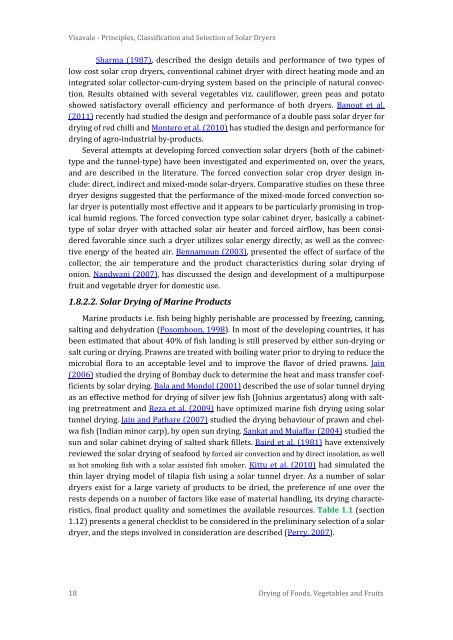Solar Drying: Fundamentals,Applications and Innovations - National ...
Solar Drying: Fundamentals,Applications and Innovations - National ...
Solar Drying: Fundamentals,Applications and Innovations - National ...
You also want an ePaper? Increase the reach of your titles
YUMPU automatically turns print PDFs into web optimized ePapers that Google loves.
Visavale - Principles, Classification <strong>and</strong> Selection of <strong>Solar</strong> Dryers<br />
Sharma (1987), described the design details <strong>and</strong> performance of two types of<br />
low cost solar crop dryers, conventional cabinet dryer with direct heating mode <strong>and</strong> an<br />
integrated solar collector-cum-drying system based on the principle of natural convection.<br />
Results obtained with several vegetables viz. cauliflower, green peas <strong>and</strong> potato<br />
showed satisfactory overall efficiency <strong>and</strong> performance of both dryers. Banout et al.<br />
(2011) recently had studied the design <strong>and</strong> performance of a double pass solar dryer for<br />
drying of red chilli <strong>and</strong> Montero et al. (2010) has studied the design <strong>and</strong> performance for<br />
drying of agro-industrial by-products.<br />
Several attempts at developing forced convection solar dryers (both of the cabinettype<br />
<strong>and</strong> the tunnel-type) have been investigated <strong>and</strong> experimented on, over the years,<br />
<strong>and</strong> are described in the literature. The forced convection solar crop dryer design include:<br />
direct, indirect <strong>and</strong> mixed-mode solar-dryers. Comparative studies on these three<br />
dryer designs suggested that the performance of the mixed-mode forced convection solar<br />
dryer is potentially most effective <strong>and</strong> it appears to be particularly promising in tropical<br />
humid regions. The forced convection type solar cabinet dryer, basically a cabinettype<br />
of solar dryer with attached solar air heater <strong>and</strong> forced airflow, has been considered<br />
favorable since such a dryer utilizes solar energy directly, as well as the convective<br />
energy of the heated air. Bennamoun (2003), presented the effect of surface of the<br />
collector, the air temperature <strong>and</strong> the product characteristics during solar drying of<br />
onion. N<strong>and</strong>wani (2007), has discussed the design <strong>and</strong> development of a multipurpose<br />
fruit <strong>and</strong> vegetable dryer for domestic use.<br />
1.8.2.2. <strong>Solar</strong> <strong>Drying</strong> of Marine Products<br />
Marine products i.e. fish being highly perishable are processed by freezing, canning,<br />
salting <strong>and</strong> dehydration (Posomboon, 1998). In most of the developing countries, it has<br />
been estimated that about 40% of fish l<strong>and</strong>ing is still preserved by either sun-drying or<br />
salt curing or drying. Prawns are treated with boiling water prior to drying to reduce the<br />
microbial flora to an acceptable level <strong>and</strong> to improve the flavor of dried prawns. Jain<br />
(2006) studied the drying of Bombay duck to determine the heat <strong>and</strong> mass transfer coefficients<br />
by solar drying. Bala <strong>and</strong> Mondol (2001) described the use of solar tunnel drying<br />
as an effective method for drying of silver jew fish (Johnius argentatus) along with salting<br />
pretreatment <strong>and</strong> Reza et al. (2009) have optimized marine fish drying using solar<br />
tunnel drying. Jain <strong>and</strong> Pathare (2007) studied the drying behaviour of prawn <strong>and</strong> chelwa<br />
fish (Indian minor carp), by open sun drying. Sankat <strong>and</strong> Mujaffar (2004) studied the<br />
sun <strong>and</strong> solar cabinet drying of salted shark fillets. Baird et al. (1981) have extensively<br />
reviewed the solar drying of seafood by forced air convection <strong>and</strong> by direct insolation, as well<br />
as hot smoking fish with a solar assisted fish smoker. Kittu et al. (2010) had simulated the<br />
thin layer drying model of tilapia fish using a solar tunnel dryer. As a number of solar<br />
dryers exist for a large variety of products to be dried, the preference of one over the<br />
rests depends on a number of factors like ease of material h<strong>and</strong>ling, its drying characteristics,<br />
final product quality <strong>and</strong> sometimes the available resources. Table 1.1 (section<br />
1.12) presents a general checklist to be considered in the preliminary selection of a solar<br />
dryer, <strong>and</strong> the steps involved in consideration are described (Perry, 2007).<br />
18 <strong>Drying</strong> of Foods, Vegetables <strong>and</strong> Fruits

















